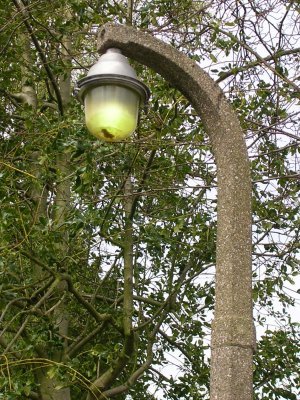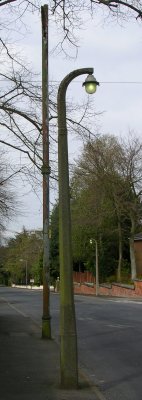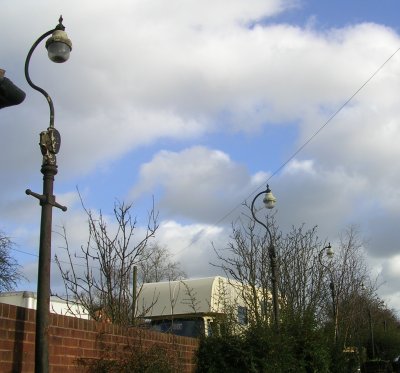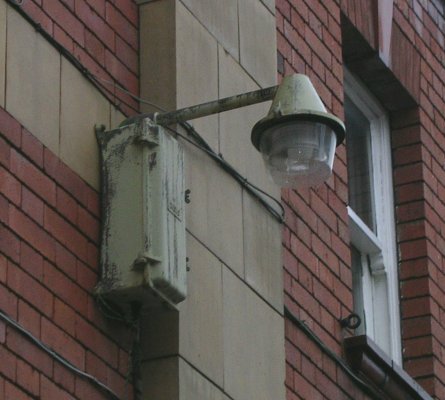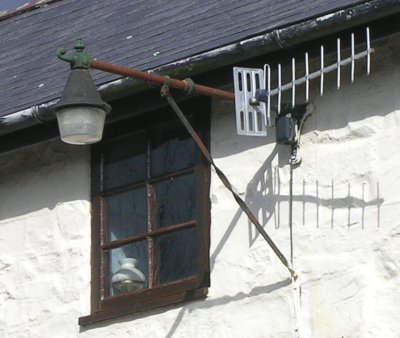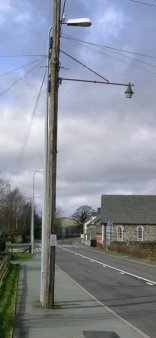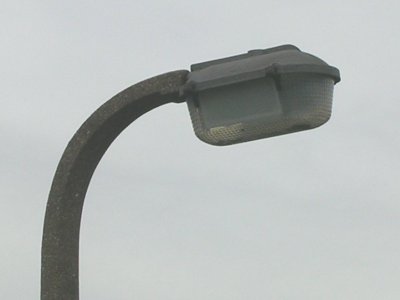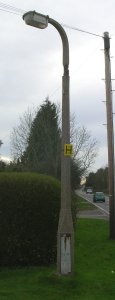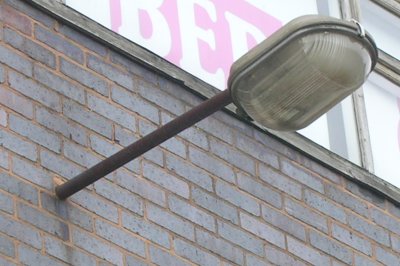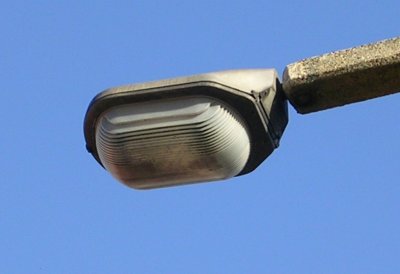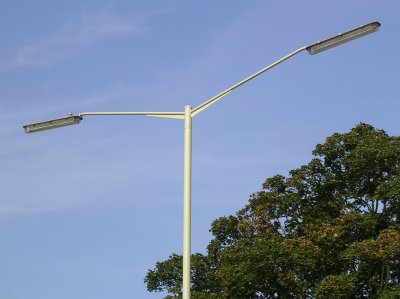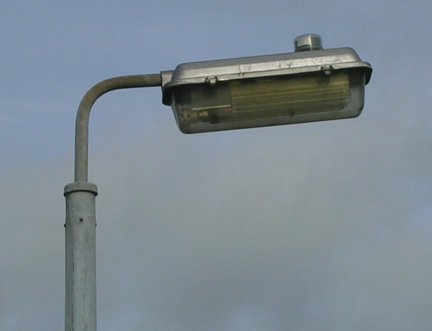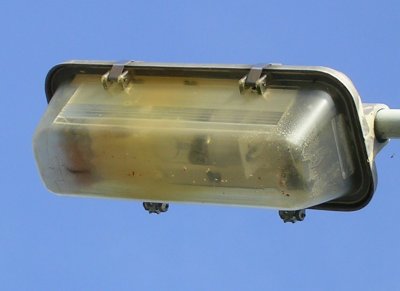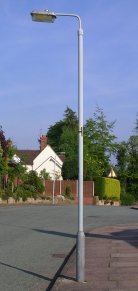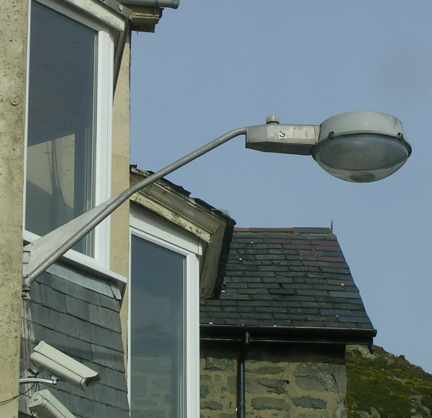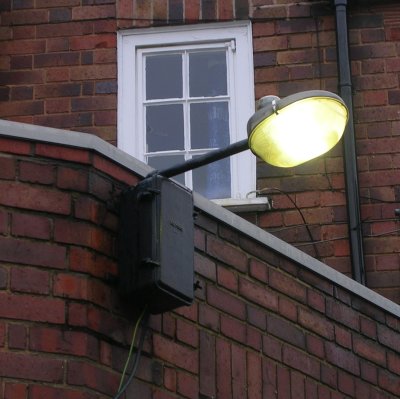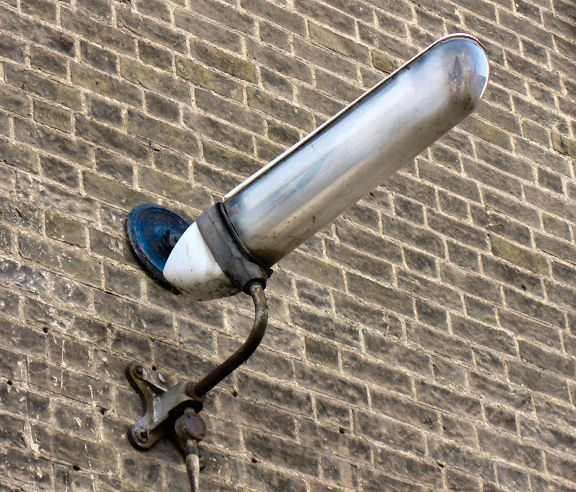REVO/Relite/Simplex, Tipton, West Midlands
- REVO C6025/6027 Leicester
- REVO C10239-10244 Leicester
- REVO C7186 Lodestar
- REVO C13566 Cut-off
- REVO C13283
- REVO C12423/AL (AKA Step-Top)
- REVO C14410 (AKA Bell-Top)
- REVO C???? Prefect
- REVO Hatfield (AKA Birmingham)
- REVO C14474 lantern
- REVO C15152/54 Sol'D-or
- REVO C13654 Silver-Blue
- REVO C13721 (AKA Baby-Dalek)
- REVO C13723 (AKA Dalek)
- REVO C???? Lucidor
- REVO C???? Horizon
- REVO C ???? Solumbra
- REVO C???? large post-top lantern (unknown type)
- REVO C14446 Haddington lantern
- REVO/Relite/Simplex C???? Hyperion A, B and C types
- Relite Gemini
- Simplex MA lantern
- Simplex Jupiter and Jupiter-Major
- Simplex Diadem and Diadem-Major
- Simplex Aries
- REVO 'Wolverhampton' column
- REVO 'Moseley' column
- REVO Crescent column
- REVO 'Candle'
- REVO Junior So-letern
REVO C6025/6027 'Leicester' lantern
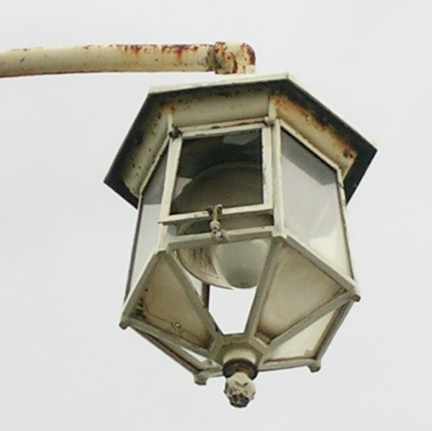
The decorative REVO Leicester came in three different sizes (12", 18", 24" max width) and for use with either GLS lamps (200w to 1500w) or mercury lamps (250w/400w). This disused C6025, 18" wide lantern is seen in Wolverhampton, West Midlands. These two lanterns and the columns had gone by late 2009, presumed scrapped.
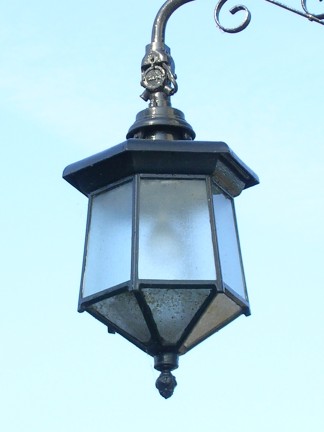
Here's a more complete REVO Leicester (apart the fact that it's missing its refractor ring). This is a C6027 model for tungsten lamps up to 500w, and was photographed attached to a wall bracket on the side of a public house in Lowdham, Nottinghamshire in June 2006. Note the condensation box above the lantern with the wires protruding; these were designed to prevent condensation from running inside the bracket and down onto the lamp.
Revo A10239-C10244 Leicester lantern
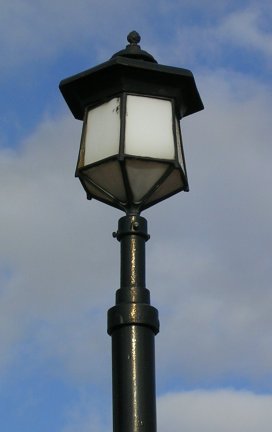
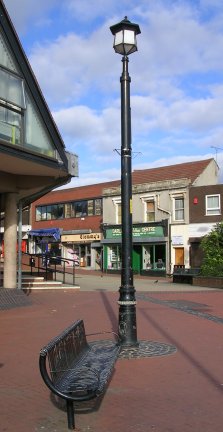
Revo Leicester C10242 post-top lantern at Darlaston in the West Midlands. Although originally designed for use with tungsten lamps, this fitting now burns a high pressure sodium lamp. This grand old lantern from a bygone age is mounted on the shortened remains of a trolleybus traction pole that once stood in the centre of a traffic island supporting the overhead wires at the trolleybus terminus in the town. On the cast iron base is the legend B.E.T (British Electric Traction), and this ornamental base dates from the time when trams ran into Darlaston.
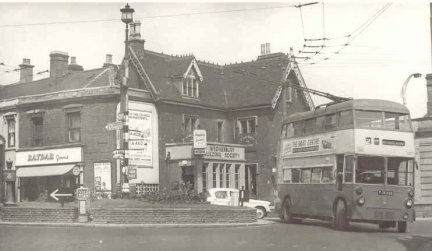
This view taken in about 1960 shows the Leicester lantern standing in the centre of the Darlaston traffic island, while Wolverhampton Corporation trolleybus No486 turns at the terminus in readiness for its return journey to Wolverhampton. Trolleybus operation to Darlaston ended in 1965, but the lantern remained in the centre of the traffic island until the junction was rebuilt in the 1970s. Photo: Claire Pendrous Collection.
REVO C2626 Lodestar GLS lantern
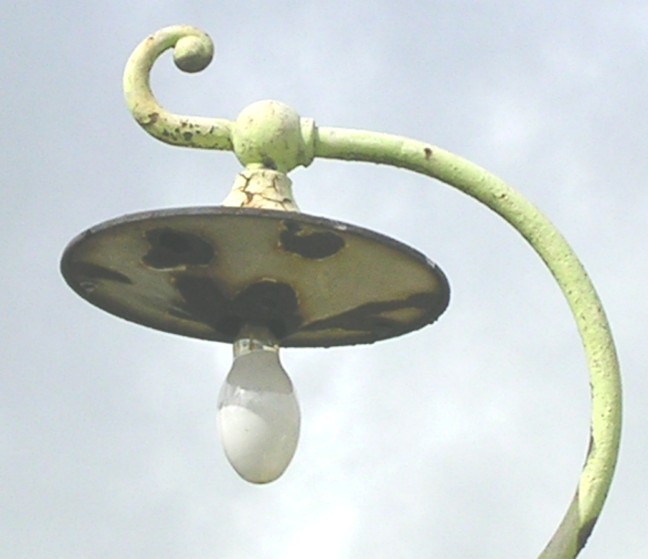
Pictured in 2005, this lovely old REVO Lodestar is an incredible survivor from a bygone age. Still in nightly use at the time, this and two others of the type survived in a quiet residential enclave in Staffordshire. Update: Removed and replaced by August 2007, but all three lanterns saved to collection, of which two were only fit for spares.
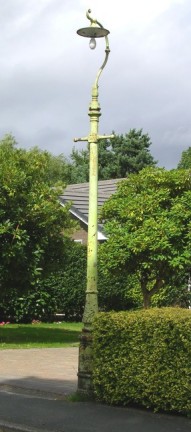
Here's a full-length view of the Lodestar mounted on its Revo 'Cannock' bracket, and set on a Revo Moseley cast iron column. I first came across these lanterns in the winter of 1981 when they were still burning 200w GLS lamps; at the time there were quite a number of them in use, but what a sight they made burning brightly on those cold murky winters evenings of long ago. This picture was taken 24-years later, on 29th August 2005, by which time only three remained, but all three were still operational. Update: All removed and replaced by August 2007, but all three lanterns saved to collection, of which two were only fit for spares.
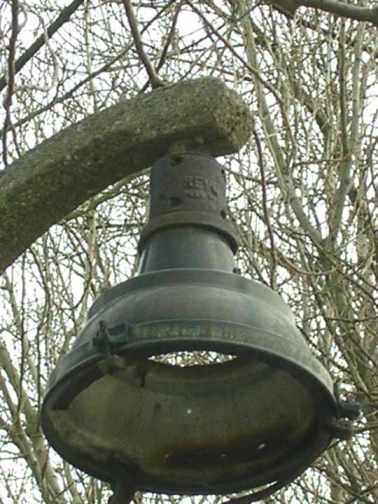
Gently rusting away on a disused WWII airfield at Langar, Nottinghamshire is this REVO cut-off lantern for GLS lamps. It was once one of several that could be found on the airfield, but now appears to be the only remaining example. The model type is a C13566 for 150w tungsten lamps, and it's likely that it was installed during or shortly after WWII. The airfield itself had been reactivated after the war and was in use up until 1964. The photograph was taken in March 2006.
REVO C13283 open refractor lantern
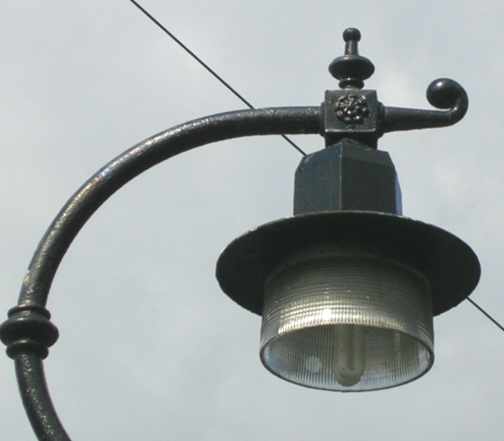
Still mounted in its original REVO swanneck bracket, this REVO C13283 open-refractor lantern for 100-200w GLS lamps was one of two of these lanterns still in use in a private road in Wolverhampton in August 2005.
REVO C12423/AL lantern (AKA Step-Top)
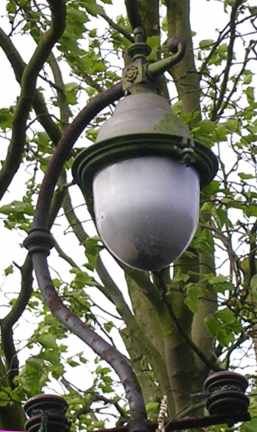
A very weathered but original REVO C12423/AL (Step-Top) with opaque plastic acorn bowl is pictured in the yard of an old factory in the West Midlands. The lantern was also available from REVO with a clear glass acorn bowl if required.
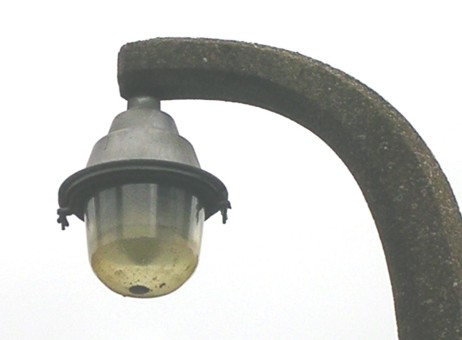
REVO C12423/AL 80w MBF lantern, and sometimes referred to as the Step-Top lantern for obvious reasons. This elderly example now has the incorrect bowl and is pictured in the Penn District of Wolverhampton in August 2005. Update: All removed and replaced by the Summer of 2007, but two examples saved into collection, a third example is in the safe hands of fellow collector John Thompson.
Likely to date from the late 1950's these lovely old Revo C12423/AL Step-Top lanterns were photographed day-burning in Muchall Road, Penn on Monday 9th April 2007. Within a week of this picture being taken, the Stanton S7 columns had been decapitated and sleeved with Holophane Syracuse lanterns fitted in place of these elderly lanterns. Update: Fortunately, two of these old mercury lanterns along with their concrete brackets were saved for posterity and are now held in the Collection, a third example is in the safe hands of fellow collector John Thompson.
REVO C14410 lantern (AKA Bell-Top)
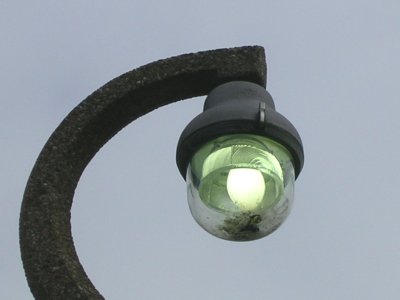
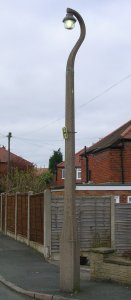
This Revo C14410 mounted onto a Stanton-S7 column is a lovely reminder of a bygone age; complete with its original glass bowl and refractor ring, the lantern is pictured 'day-burning' its 80w MBF lamp in Wolverhampton in April 2007. Update: Removed and replaced by Summer of 2007.
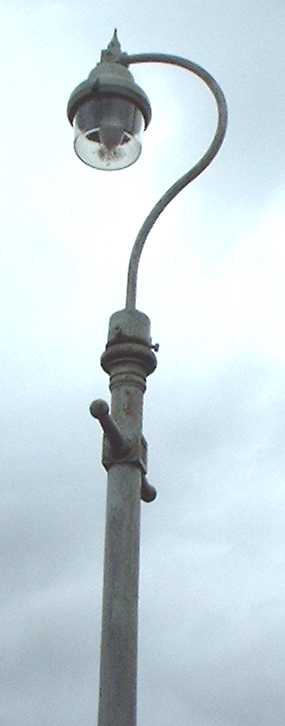
This C14410 'Bell-Top' lantern for 80w MBF lamps stood in Codsall, Staffordshire with many others of the type until 2005, when they were all removed as part of Staffordshire's PFI renewal scheme. There was a locally publicised campaign by residents to save them, or at least the REVO cast iron columns, but sadly this appears to have failed.
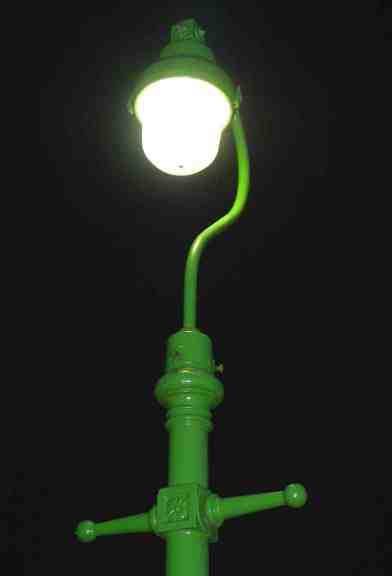
This privately owned C14410 is mounted on to a REVO cast iron column and is seen lit at night in its home town of Wolverhampton. The column has been painted into the original Wolverhampton Corporation green livery that was used by the Streetlighting Department up until the early 1960's.
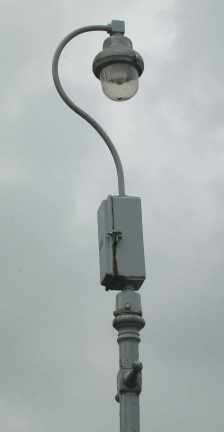
This REVO Bell-Top with retro fitted vacuum-formed plastic bowl and minus refractor ring, is mounted on a REVO B14052 bracket and control box combination; the column is REVO too. The photograph was taken in Wolverhampton in 2006, shortly before the column was removed.
These five ex Birmingham City Council Revo Bell Tops mounted onto Revo Moseley Columns are to be found in the car park of a Farm Shop situated on the A5 at Norton Canes in Staffordshire'. Photo: January 2007.
This REVO Prefect is a Staffordshire based example and resides in the village of Seisdon, near Wolverhampton. Photographed in the Winter of 2005, the lantern still retained its glass bowl, but has been fitted with a two-part photocell. This fitting is attached to a long out-reach bracket for wood pole mounting, but its days are sadly numbered as the PFI renewal scheme for Staffordshire will eventually see it replaced.
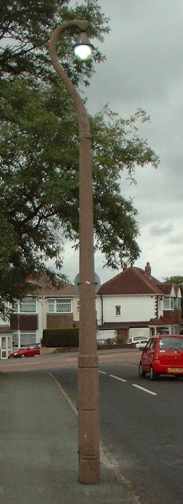
Still attached to this Stanton S7 column is a REVO 80w MBF 'Prefect' lantern with glass bowl, which is likely to be the column's original lantern. Pictured under threatening skies, the lantern is seen day-burning in 2004. Update; This lantern was replaced with an Industria 2600 70w SON lantern in 2006; However, the 'Prefect' was saved for the Collection.
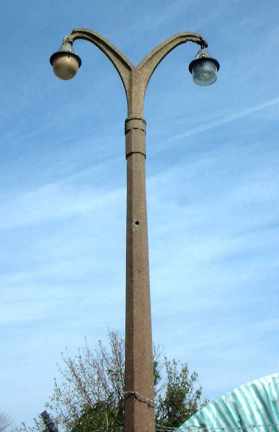
REVO 80w MBF 'Prefect' lanterns on a twin-armed Stanton column in Hednesford, Staffordshire in 2003. The lantern on the right retains its original glass bowl, but the lantern on the left has at sometime received an 'Eleco HW852' type plastic bowl. Update: Still in situ in mid 2007, but bowl missing from lantern on left.
This elderly side-entry REVO Prefect hasn't been coaxed into life by the gloom of a dark, wet, and dank afternoon in Dudley, despite the fact that the next mercury lamped lantern along the narrow back road is burning brightly. There's no sign of a photocell, so it's likely that this rare lantern is still controlled by an electro-mechanical time switch that's hidden away inside the large REVO control box? Photo:16th January 2007.
Despite having been replaced by column mounted SON lamped WRTL MRL8's some years ago, these lovely old REVO Prefects still remain in situ at the roadside of the A458 at Foel in Mid Wales. Now that house owners have attached their UHF TV aeriel to the redundant AC Ford bracket, it will at least prolong the life of one of these old fittings. Picture: March 2007.
REVO C14106/7 Hatfield lantern (AKA REVO Birmingham)
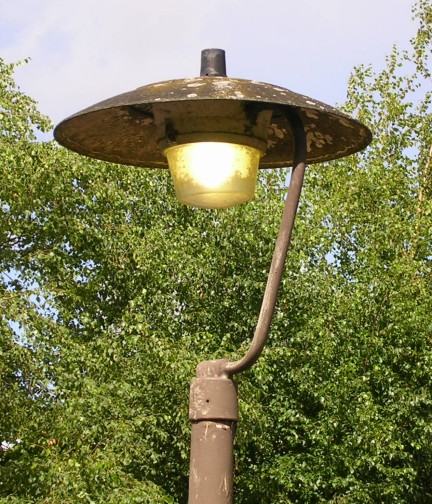
1. This unusual design of enclosed lantern incorporated with its bracket under a huge fibreglass canopy, appears to have been unique to Birmingham in the 1960's; happily, many of the type can be still be found in use in the City's suburbs. Outside of Birmingham, REVO offered the Hatfield as an open-refractor lantern for GLS lamps, but whether Birmingham City Council ever used these themselves is not known. Today, Birmingham is the last great bastion for mercury lighting in the Britain, with some 24,000 mercury lanterns of various types still in use in 2006; not surprisingly all the remaining REVO Hadfields run 80w MBF lamps. However, like so other local authorities in the UK, Birmingham City Council is looking to implement its own PFI scheme, and this is likely to happen in September 2007, signalling the end for these wonderful old lanterns, and indeed all of the City's remaining mercury lighting installations.
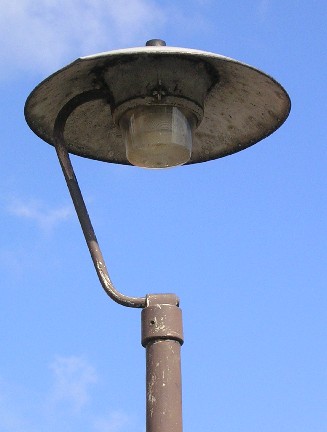
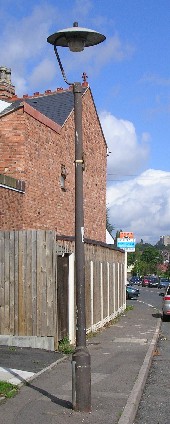
2. Here's another Hatfield lantern for 80w MBF lamps, but this one has a metal spun canopy. Apparently, these lanterns were offered to Birmingham City Council with metal canopies for two or three years during their production. Pictutres taken in Erdington, Birmingham, Septmeber 2006.
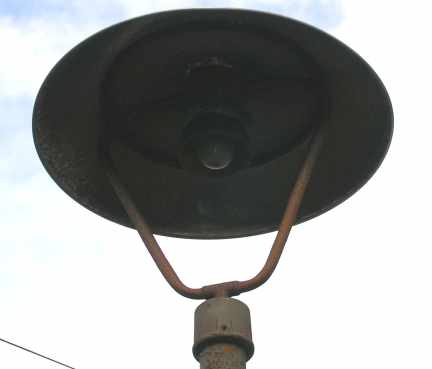
3. The C14107 double bracket open-refractor Hatfield has to be the rarest of the REVO 'Hatfield' family; this long disused example complete with GLS lamp is situated near to the town of Dudley in the West Midlands.
REVO C14474 decorative post-top lantern
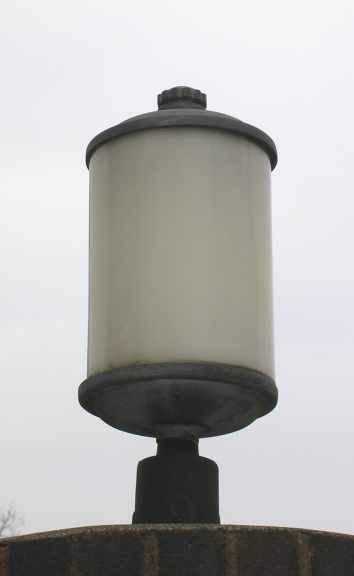
Mounted on top of a gateway wall of a property in Wolverhampton are a pair of these disused REVO C14474 decorative post-top lanterns for use with either 60w-200w tungsten lamps or 80w/125w mercury lamps. Update: This particular lantern was destroyed in an act of vandalism in January 2007.
REVO C15152 and C15154 Sol-D'or' lanterns
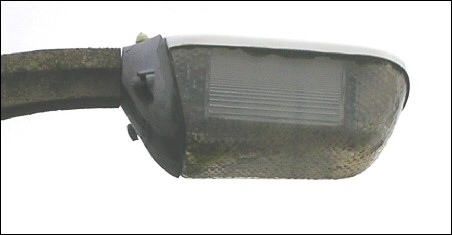
1. An example of a REVO C15152 Sol-D'or' originally designed for use with 45/60w SO sodium lamps, but now using a 35w SOX sodium lamp. This particular lantern is photographed in Wolverhampton in 2005 and is an example of the smaller variant of the type. At one time, Sol-D'or's could be found in numbers in residential areas on the South East side of the City, mainly in the Bilston area; but very few survive today. The lantern itself is sometimes compared with the Thorn Alpha-One because the one-piece plastic canopy and bowl are removed from the lantern as a single unit, but in reality the Sol-D'or' is of a very different design and was never anywhere near as popular as the Thorn Alpha-One lantern. Outside of private collections, very few Sol-D'or's still exist in the UK today. Update August 2006: This lantern along with five other similar examples at Parkfields, Wolverhampton were scrapped in July 2006 following the implementation of a street lighting renewal program for the area.
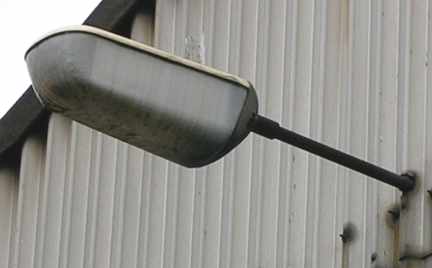
2. This is the larger REVO C15154 Sol-D'or' for 140w SO lanterns. This disused example is picture attached to a factory in the West Midlands.
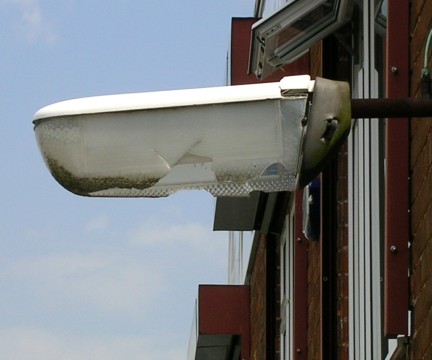
3. Here's another disused 85/140w SO, 90w SOX Sol-D'or' attached to the side of a factory, but this one's a little worse for wear after falling victim to the attention of vandals from a local housing estate in Nottingham. The damaged lantern reveals the plastic flange at the back of the Bowl/canopy assembly where the toggle clip fastens; this is one of the Sol-D'or's weak points and appears to be broken on this example, hence the bowl coming away from the housing. Photo June 2006.
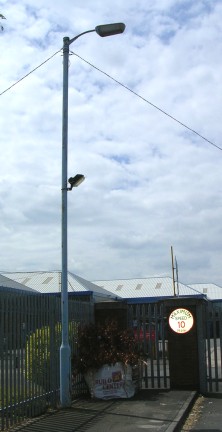
4. Another REVO Sol-D'or (for 85/140w SO 90w SOX lamps), but this one's a column mounted example seen in Wolverhampton, West Midlands in June 2006.
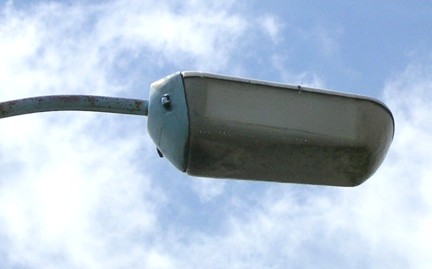
5. A close up of the Wolverhampton Sol-D'or lantern.
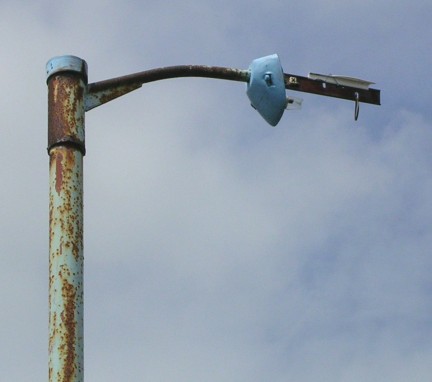
6. Here's another example, but sadly this one has been vandalised; however, it does reveal the 'slide-bar' onto which the bowl assembly was fitted.
REVO C13654/S Silver-Blue lantern
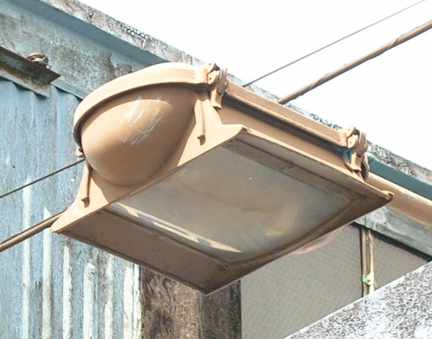
REVO manufactured a whole family of mercury lanterns for the Silver-Blue range for all sorts of applications. This example seen on the side of a factory in the West Midlands is a C13654/S 'cut-off' Silver-Blue lantern and uses a 250w MB/U lamp; it was still in use in 2004.
REVO C13721 lantern 60w SO lantern (AKA baby-Dalek)
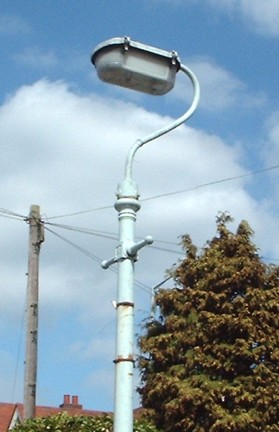
Revo's C13721 lantern for 60w SO lamps were never as popular as its bigger brother the C13723 lantern for140w SO lamps (see below), but still the type saw extensive use with some Councils, especially in rural and suburban areas. This integral-geared version used to stand in Woodfield Avenue, Wolverhampton until its removal in 2004, and was the last of its type in the City; fortunately, it is now safely stored in the collection along with its uniquely shaped REVO bracket.
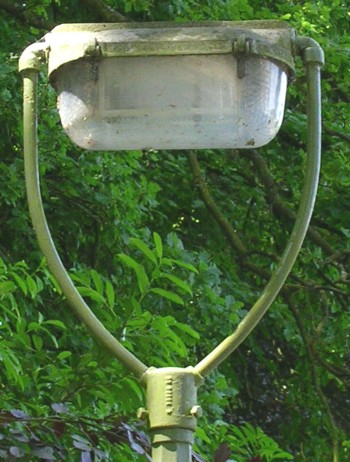
Mounted in a modified REVO 'Vanguard' harp bracket, on a REVO 'Woolwich' column, is this unusual double-ended Baby-Dalek lantern, seen in Haselmere, Surrey in July 2005.
This lovely example of a Revo C13721S 60w SO lantern, mounted onto a rare Revo 'Angelo' concrete column was pictured in Worcestershire in March 2007.
REVO C13723 lantern 140W SO lantern (AKA Dalek)
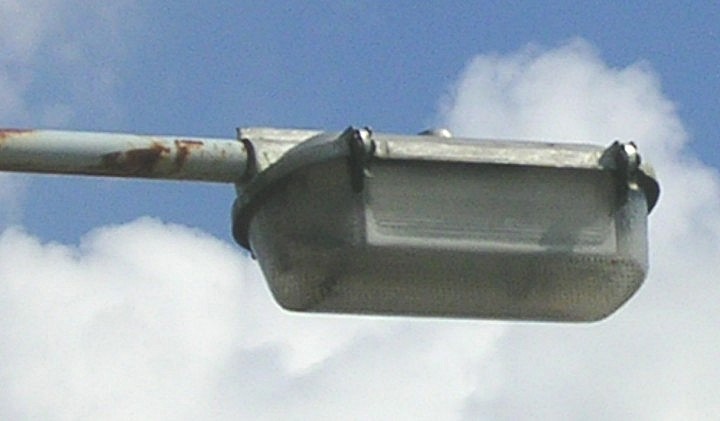
The C13723 was a very popular lantern with many local authorities and streetlighting departments in the late 1950's and early 1960's for main road lighting. The lantern was designed for use with 140w SO sodium lamps, but these days surviving examples normally use 90w SOX sodium lamps. The C13723/S pictured ('S' meaning side-entry) once stood on Trysull Road in Wolverhampton, but has since been removed. However, other C13723/S's are still in evidence in the City's suburbs.
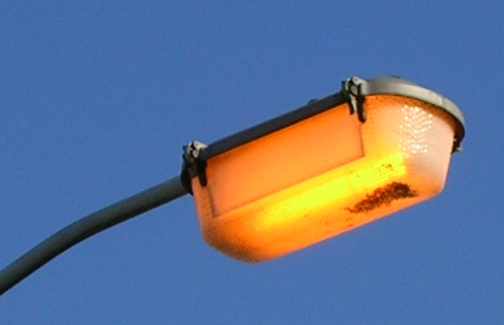
Wolverhampton was a big customer of REVO products and many examples can still be seen around the City - if you know where to look. This C13723/S was photographed day-burning in Finchfield Lane, Wolverhampton in April 2006. This particular lantern was replaced with a Holophane Syracuse lantern shortly after this photo was taken.
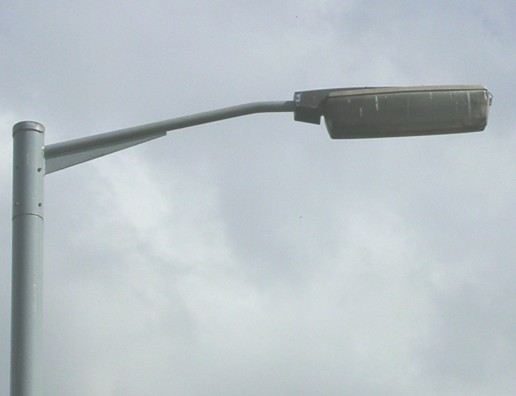
There were many variants of the Lucidor. This 90w SOX remote-geared version in Wolverhampton is probably the most popular version with the square section over-shoe, originally intended for use with concrete column out-reaches; this style of of Lucidor is a classic 1960's design.

Lucidors were once quite common in Wolverhampton, but very few remain. This 90w SOX example survives in a backstreet of the city.
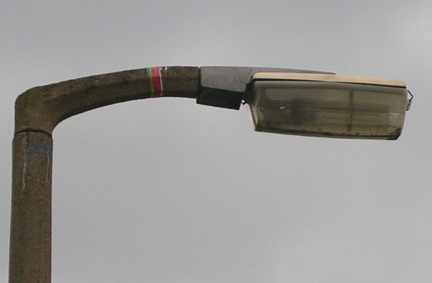
Revo also made this smaller version of the remote-geared over-shoe Lucidor; this one is for 35w SOX lamps and is seen in Wednesbury, West Midlands.
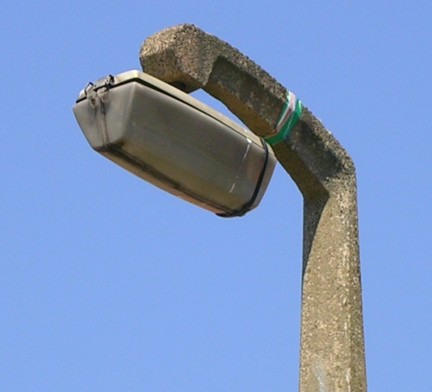
Yet another version of the Lucidor was the top-entry remote-geared lantern for 35w SOX lamps; this example is seen in Sandwell in June 2006
This gear-in-head version of the Lucidor for 90w sodium lamps is seen on the A496 Barmouth to Harlech Road in North Wales in September 2005. Altered to incorporate the control gear within the lantern itself, the sleek lines of the remote-geared version are lost in this rather ungainly and bulky design. Revo/Relite also made a smaller, but similar looking 35w version of this gear-in-head lantern (see below). Update: These geared Lucidors on the A496 had been replaced with modern SON lanterns during late 2006.
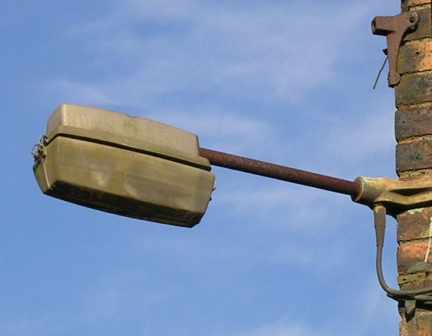
Mother nature seems to be getting the better of this disused 35w gear-in-head Revo Lucidor pictured on the side of a factory in Wolverhampton in the Spring of 2006.
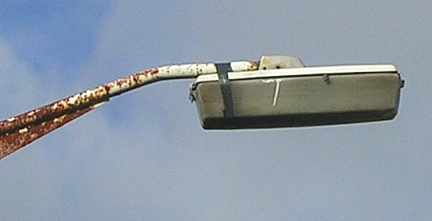
Another version of the Lucidor, this time with small spigot receptor for mounting on to steel brackets. As with most Lucidors that are still extant, this Wolverhampton example has a bowl that is in poor condition.
Revo C???? Horizon lantern
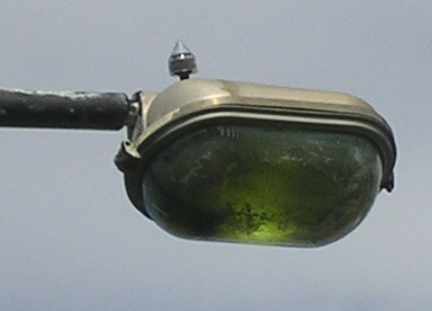
The remote-geared Revo Horizon lantern for 250w mercury lamps is of a very pleasing design, and could be considered to be a bigger version of the Revo Diadem lantern. This example pictured in Wolverhampton is a later model; the earlier version had a differently shaped canopy, which was more suited to mounting on concrete brackets. This Horizon had been dayburning for many months when the picture was taken in September 2005; the greenish glow from the tired lamp indicates that the lamp is nearing the end of its life.
Seen in Worcestershire, this Revo Horizon employees a prismatic glass bowl with bold straight-ribbed patterning that is different from the example above.
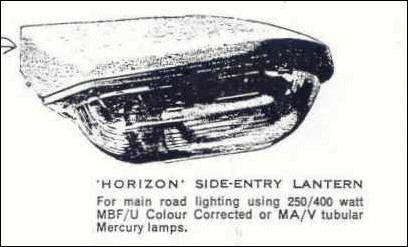
A picture taken in Staffordshire in January 2008 showing an early type remote-geared Revo Horizon, specifically designed to fit onto concrete brackets. This one has a retro fitted plastic bowl, presumably having lost its original glass bowl at sometime in the distant past. According to the Revo catalogue, These early Horizon lanterns could be used with either high pressure MB mercury lamps, or medium pressure MA/V mercury lamps. However this example held a 400w MBF lamp, but no 'magnetic arc deflector' present in it for burning MA/V lamps. This lantern was rescued for the Collection on 30th January 2008, a second example which was also saved has gone to John Thompson's street lighting collection.
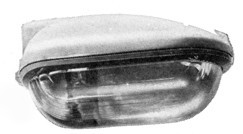
This image from a later Revo catalogue illustrates how the lantern's profile was altered for mounting on to tubular steel brackets.
REVO C???? Solumbra post-top Lantern
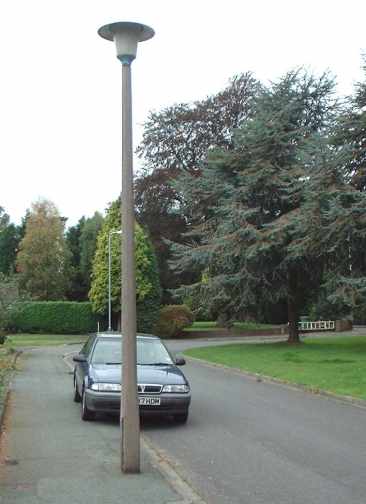
This is an early 60's example of a REVO Solumbra lantern that stood off the Wergs Road in Wolverhampton in 2004. This big 'hatted' version is still in its original light blue painted finish used on these earlier Solumbras. At the time of the picture the lantern was running a 35w SOX sodium lantern, but was originally designed for use with 60w SO sodium lamps (now 35w SOX). This lantern is now held in the collection.
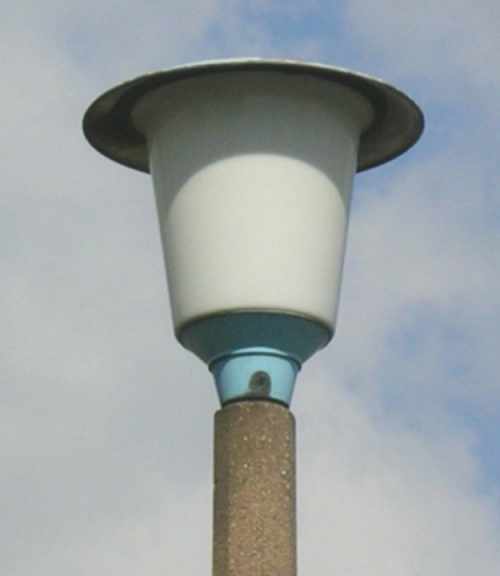
Another early 1960's example of the Solumbra in the blue painted finish. This one is a HPMV version for use with 80/125w MBF lamps and has the smaller diameter 'tin-hat'. The spun-metal 'tin-hats' on these earlier Solumbras were first galvanised and then painted during the manufacturing process, which is why so many early examples have endured the passing decades in such good condition. Again, this Solumbra is another example from Wolverhampton.
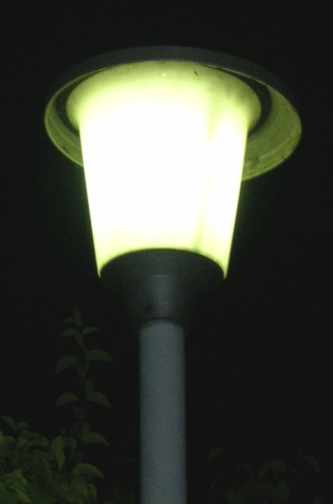
A Simplex Solumbra burns brightly in a quiet residential side road in Wolverhampton in 2005. This near-end-of-production Solumbra sports the later aluminium 'Dustbin-lid' hat, so called because that's what it looks like with its deep-sided rim.
REVO C???? large post-top sodium Lantern
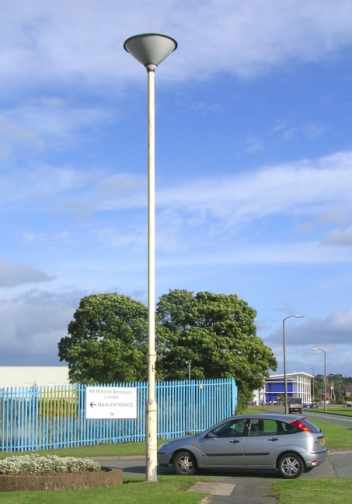
Thought to be a REVO product these large post top lanterns were once a common site around Wolverhampton City Centre until replaced by Simplex Jupiters in the early 1980s. This lantern mounted on its 10 metre steel column was pictured in Fordhouses, Wolverhampton in October 2005 and is the last one of its type in the town. Despite attempts to save it, this lantern and column were taken down in 2009 and lost to the skip.
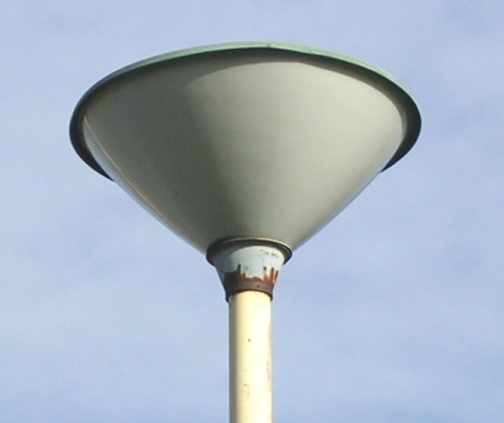
A close-up of the same lantern; no doubt a 1960's rival to some of the large post-top lanterns made by GEC. It is thought that the lantern employs 3 x 90w SOX lamps. This really is a big lantern and is probably in excess of 4ft in diameter at it widest point.
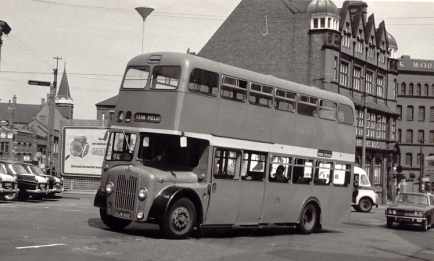
This photograph of a busy Victoria Square, Wolverhampton, in the late 1960's, was taken at a time when fluorescent lighting was being phased out in favour of low-pressure sodium lighting. One of the new generation of REVO post top lanterns is already in place and can be seen behind the passing Guy Arab motorbus. To the left of the picture are two large 1950's REVO fluorescent lanterns for 5', 80w MCF tubes mounted on redundant trolleybus traction poles; these would soon be removed as more of the large REVO Post tops were installed to replace them. Photo: Claire Pendrous collection.
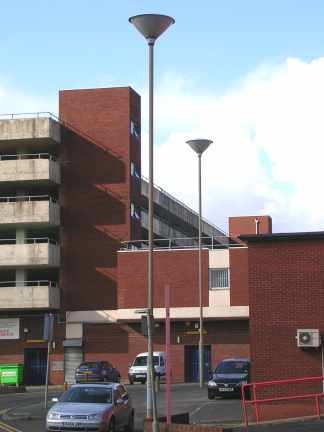
Here are a couple of other REVO Post tops that still existed in Stourbridge in the West Midlands in the Spring of 2006; these are on taller 12-metre columns. Still insitu in early 2010.
REVO C14446 'Haddington' Fluorescent lantern
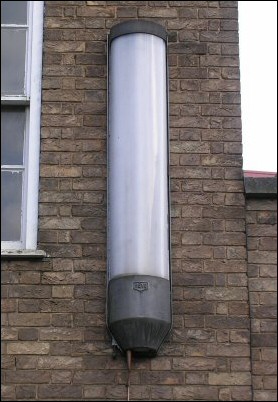
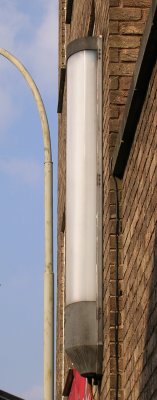
Amazing survivors from a bygone age are these two Revo 'Haddington' fluorescent lanterns in Dudley in the West Midlands. Designed for, and named after the town of Haddington in Southern Scotland where the type originally saw use. These wall mounted lanterns house three 5ft 80-watt MCF tubes beneath the opal perspex lamp cover, and incorporate a stainless steel reflector plate that can be hinged forward to access the control gear mounted into the back of the lantern. Now in the hands of collector John Thompson.
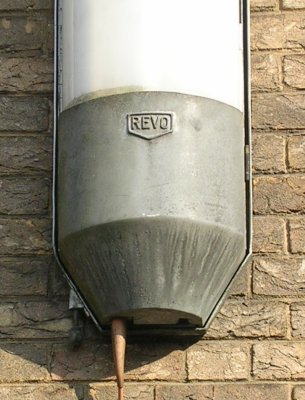
The whole of the front of the lantern can be hinged open by releasing the sliding bolt on the left side of the base of the unit. Note the hinges on the right side of the lantern's cover.
REVO C???? Hyperion A, B, and C types
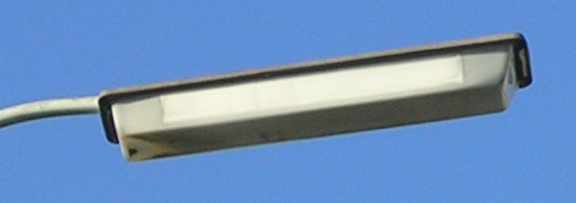
A 1960's REVO Hyperion 'A' in use with a modern 135 SOX lamp is photographed in Wolverhampton in 2005. Not too noticeable in this view is the 'bellied' bottom to the bowl that is synonymous with the Hyperion 'A', but this was discontinued on the Hyperion 'B' model. This 'Wolverhampton' Hyperion 'A' remained in regular nightly use until Thursday 11th May 2005, when it and others were finally taken down after 40+ year's service, and replaced with Holophane Syracuse 150w high pressure sodium lanterns.
A 1970's REVO/Relite Hyperion 'B' 135w /150w SOX lantern. These were basically a cheaper, lightweight version of the Hyperion 'A' with a thin pressed aluminium canopy. The most distinguishing feature of the Hyperion 'B' is the long inverted 'vee' refractor on the underside of the bowl.
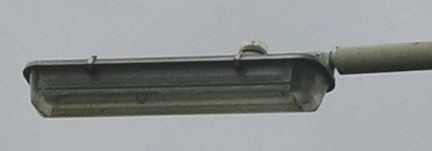
The Simplex Hyperion 'C' lantern for 135w SOX lanterns. It's easy to mistake this lantern for the similar looking GEC Z9554 135w SOX lantern below, but the front corners of the Hyperion's canopy ares more rounded than the Z9554 and the refractor panels in the bowl are longer. This Hyperion 'C' was photgraphed near Dudley in the West Midlands.

Here's a GRP canopied GEC Z9554M as a comparison to the Hyperion 'C'. The squarer front to the canopy and the shorter refractor panel in the bowl can be seen. Had it been the aluminium-canopied version of the GEC Z9554 it would have looked even more like the Hyperion 'C' above.

A 1980's Simplex Hyperion 'C' lantern for 180watt SOX sodium lanterns, pictured in Wolverhampton. This is the larger version of Simplex's 135w Hyperion 'C' lantern and the family resemblance is clear to see.
Relite/Simplex Hyperions for 180w SOX lamps on a twin armed Fabrikat bracket, are amongst the few remaining examples on the A461 at its junction with Barracks Lane near Brownhills in Staffordshire, most having been replaced by Philips MA60s over the years. Picture September 2006.
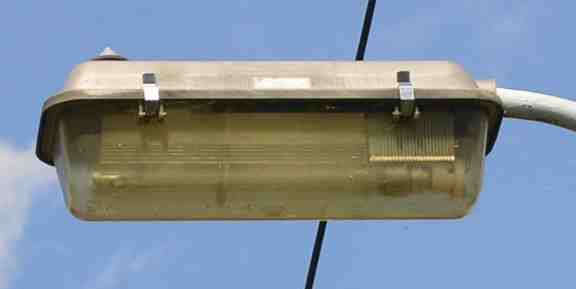
1. A Relite/Simplex Gemini 'geared' lantern for 55w SOX lanterns on a REVO swanneck bracket in Kimberley, Nottinghamshire in the Summer of 2005. Sadly, both the lantern and its cast iron column have since been removed.
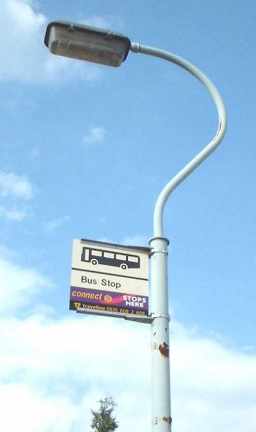
2. Another Relite/Simplex Gemini lantern, but this is the shorter 35w SOX version; the picture was taken in Toton, Nottinghamshire in 2004.
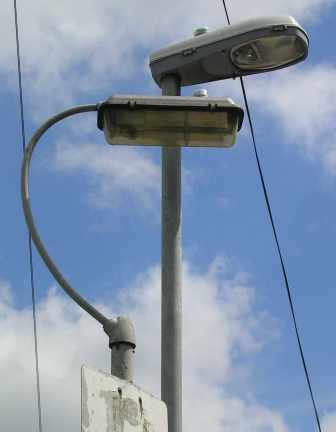
3. The days are numbered for this Relite/Simplex Gemini 55w SOX lantern on a REVO 'Vanguard' bracket in Bingham, Nottinghamshire. The replacement lantern is an Urbis ZX1 cut-off lantern for 70w SON lamps. Update; This lantern and column had been removed by February 2007.
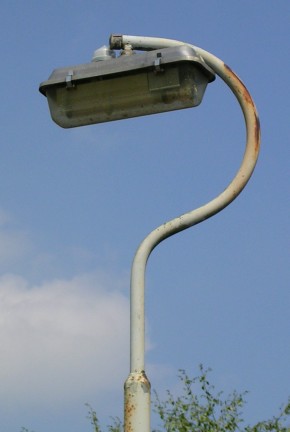
4. This top-entry version of the 55w Gemini is seen skewed on its swanneck mounting; probably deliberately done because the lantern is too big for the arc of the bracket. This one's unusual in Nottinghamshire because most top-entry Geminis have another top-entry mounting set further back on the top side of the canopy. Picture taken in Lowdham, Nottinghamshire in June 2006.
5. Here's an example of a 55w Gemini with a set-back top-entry mounting point. Picture taken in Sutton-in-Ashfield, Nottinghamshire in March 2006.
6. This 35w SOX Gemini bathes in autumn sunshine in a small residential cul-de-sac in Welshpool in October 2006.
The 35-watt SOX Gemini was later developed into a 70w SON-T lantern by Simplex, but it's difficult to find examples of this rare variant. This one was pictured in Wolverhampton in April 2007. Note that the lamp holder is set further forward on the gear tray than the 35w SOX version above, this was done to position the shorter 70w SON-T lamp more centrally inside the lantern. See the example that's held in the collection here.
Simplex top-entry 250/400w MA lantern
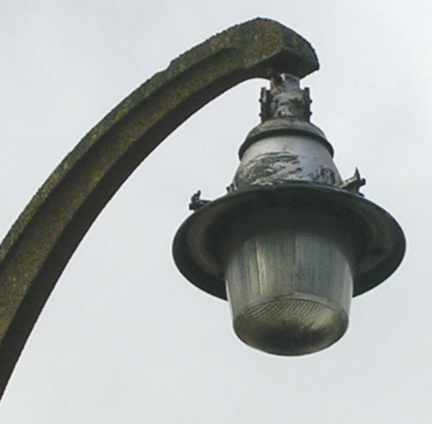
A Simplex top-entry lantern for 250/400w MA lamps pictured in Tividale, West Midlands, May 2006. There used to be hundreds of these lanterns in the near-by town of West Bromwich in the 1950's, but this is probably the last survivor outside of preservation. I did save an identical lantern for the collection in 2003, but later passed it on to fellow collector Bob Cookson.
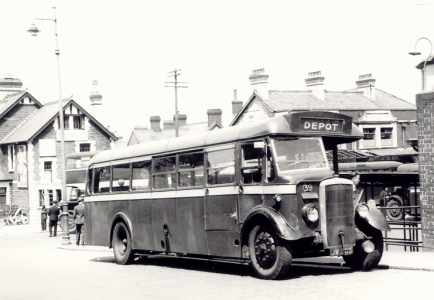
This magnificent West Bromwich Corporation Daimler motorbus is photographed in its home town on a sunny day during the mid 1950's. To the left of the picture can be seen one of the Simplex MA lanterns that would have been found in West Bromwich at that time. Photo Roy Marshall, c/o Claire Pendrous collection.
Simplex Jupiter and Jupiter-Major lanterns
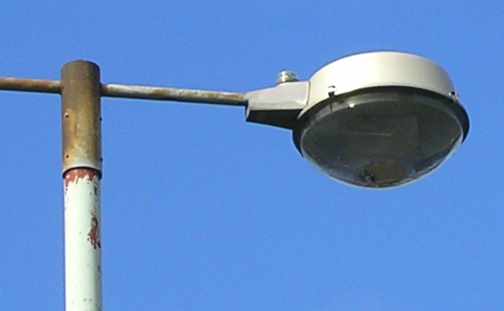
A late-in-the-day rival to the Thorn/Atlas Alpha 3 and GEC turtle lanterns, the Simplex Jupiter is very similar in that it's a large, lightweight lantern for main road use. Designed to be used with large elliptical MPMV or HPS lamps, the Simplex Jupiter never gained much popularity with local authority lighting departments and was probably quite dated when it appeared in the late 1970's. However, Wolverhampton remained loyal to Simplex and purchased quantities of remote-geared Simplex Jupiters for use around the City Centre and on the City's Ring Road in the early 1980's. In the main, these Jupiters replaced REVO/Relite Hyperions and large REVO post-top SOX lanterns, but now many of the Jupiter's have themselves been replaced with Urbis ZX3's. This remote-geared Jupiter was still extant in the City, and was one of two seen on this twin-bracket in Chapel Ash in the Summer of 2005.
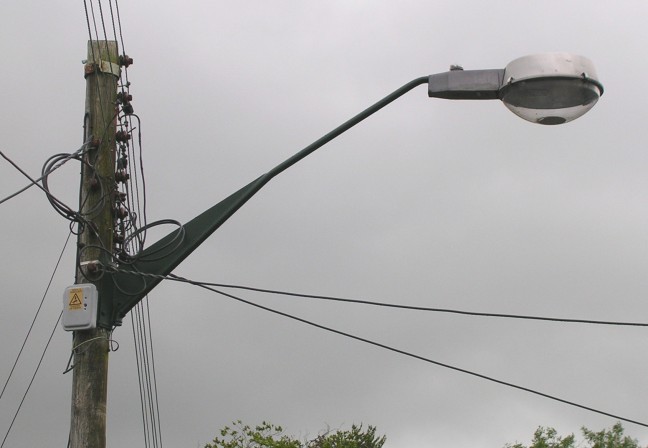
Rain threatens on the day that this photograph was taken in Festiniogg, North Wales in August 2005. This is a Jupiter-Major (the geared version of the the Jupiter) with its extended 'shoe' to incorporate the control-gear. It was one of a number still in use in and around the town at the time. One of these 'geared' Jupiter's from Festiniogg is saved to the collection.
Another Welsh Jupiter-Major, this example for 250w SON lamps is in Barmouth, North Wales, close to the Town's Railway Station. The rooms behind don't appear to have curtains; if they're bedrooms, then the occupants must be very tolerant to put up with the lantern's glare at night.
Diadem and Diadem-Major lanterns
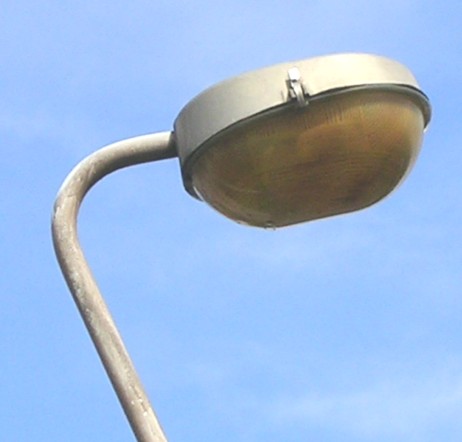
Simplex Diadem remote-geared lantern for use with 80w/125w lamps. This diminutive 80w MBF lantern was photographed in Longbridge, Birmingham in August 2005. Note that the Simplex Diadem has a deeper canopy than its Relite predecessor.
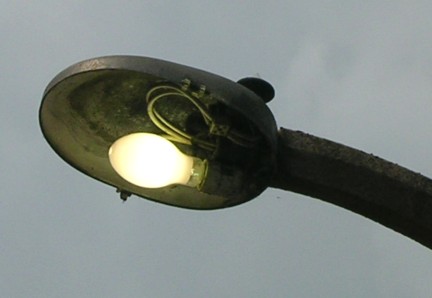
A bowl-less Relite Diadem with 80w MBF lamp, seen day-burning in Nottingham in June 2006. The Relite Diadem can be distinguished from the Simplex version by it shallower and more rounded edged canopy. Since removed by Nottingham City Council.
Mounted on its AC Ford bracket and control box, this elderly Relite Diadem is seen day-burning in an alley way in Dudley Town Centre on a dull and rainy day in January 2007.
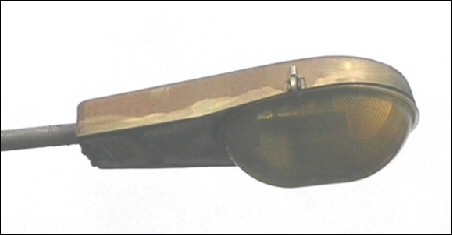
Diaden-Major lantern for 125w MBF lamps pictured in Dolgellau, N Wales in September 2005. This is the 'geared' version of the Diadem.
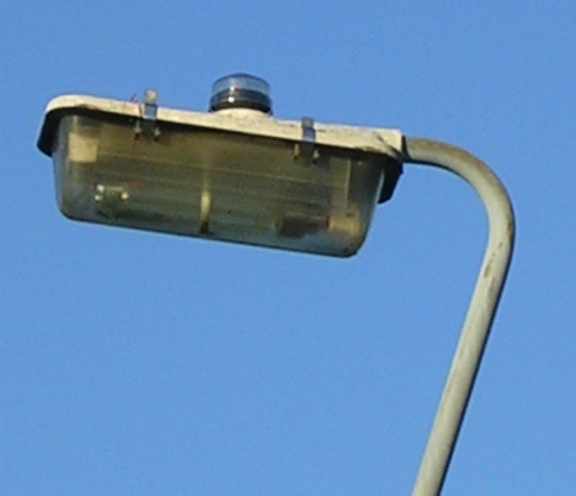
The fibre glass canopied Simplex Aries was the replacement for the Relite/Simplex Gemini lantern, and like the Gemini was available for use with 35w and 55w SOX lamps. Its design was very similar to the GEC/Seimens/WRTL Z9538/SRL35-55 lantern, and was in fact its rival until production ceased in the late 80's when the streetlighting interests of Simplex Lighting Ltd passed to WRTL; the Aries duplicated WRTL's existing SRL35-55 lanterns. This 35w Simplex Aries is one of many to be found in the sidestreets of Wolverhampton.
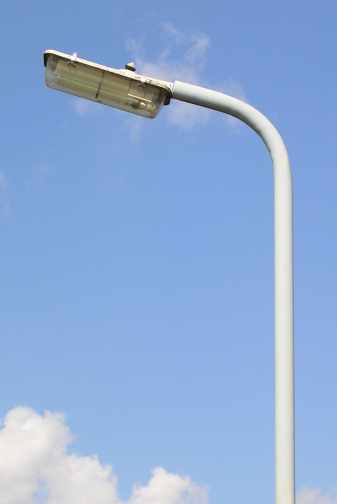
This is the larger Simplex Aries for use with 55w SOX sodium lamps, and was photographed in Watnall, Nottinghamshire in 2005.
REVO 'Wolverhampton' cast iron and steel column
Wolverhampton's last remaining REVO 'Wolverhampton' column with REVO B5354 bracket, now fitted with a totally out-of-character Industria 2600 lantern; this grand old lady is seen in Exchange Street in October 2005.
Revo 'Moseley' all cast iron Column
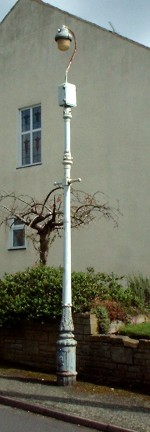
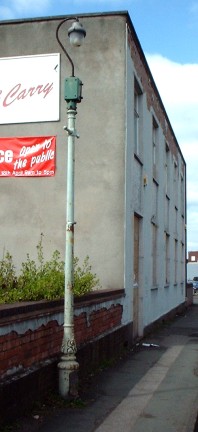

There are several different versions of the REVO Moseley. Wolverhampton Corporation used at least three different types; here are some examples:
|
Left: |
Short 10ft Moseley column; this one has had a REVO B.8712 (24inch) extension piece fitted to it to raise the lantern height. |
|
Middle |
The taller Moseley 12ft 6inch column. The A C Ford bracket on this one is still in its factory green finish! |
|
Right |
Another 12ft 6in tall column, but with lengthened base. Unlike the other types, these columns never carried the Wolverhampton coat-of-arms on their inspection doors covers, but instead just had plain cast iron covers.
|
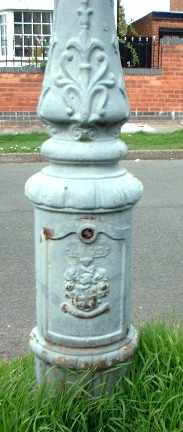
Base detail of a REVO Moseley-type column. This example is one of the thousands made for Wolverhampton Corporation in the pre-war and post-war periods and carries the City's coat-of-arms; very few of these now survive in the City.
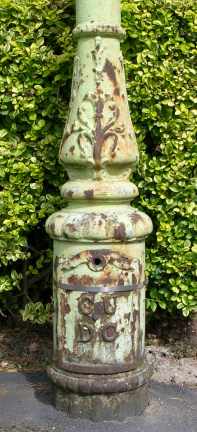
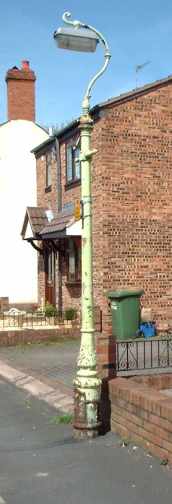
Here's a couple more REVO Moseley-type columns; these examples are two of the many once purchased by the erstwhile Cannock Urban District Council (CUDC), for use in Cannock and its surrounding districts.
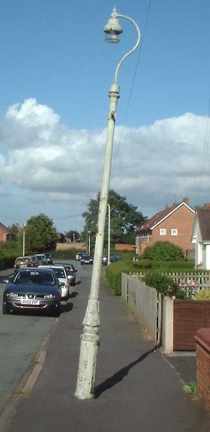
This long-base 'Moseley' in Bilbrook, Staffordshire, is seen leaning back at an alarming angle, which suggests the foot of the column has snapped off under the ground. Its positioning in the middle of the pavement seems a bit odd, but by late 2005 all the Moseleys in the area had been swept away by contractors under the PFI lighting renewal scheme for Staffordshire.
Stripped of its REVO swanneck bracket, Bell Top MBF lantern, and inspection door, this redundant Revo Moseley awaits its fate at the hands of the column pullers in June 2006. Photo: York Avenue, Wolverhampton.
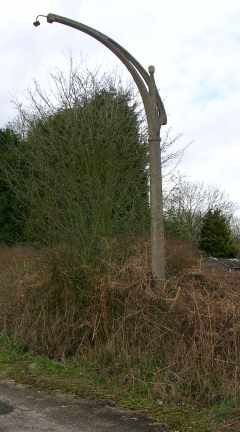
This REVO 'Crescent' concrete column with REVO B10454 bracket dates from WWII. It's one of two that still exist on a former Anti-Aircraft gun emplacement on the outskirts of Wolverhampton in 2006. My thanks to Simon Cornwell for identifying this column. Still insitu in Spring 2010.
REVO 'Candle'
The REVO 'Candle' was a take on REVO's own 'Festival' lantern, a lantern commisioned by Birmingham City Council in 1951. The REVO 'Candle' was in effect a 'Festival' lantern with a redesign base and canopy. The redesign of the lantern and the supporting column was undertaken by Sir Albert Richardson, President of the Royal Academy in the mid 1950s, specifically for use in Cambridge. Today, a number of these street lights survive in the City centre, making them the last operational postwar A-Group fluorescent installation in Britain.
REVO Junior Sol-etern
Coming from the same family as the Sol-Dor, the 'Junior Sol-tern' was a modern looking fluorescent fitting designed for use in side-roads and alleyways. The City of Cambridge took the type in its 100s to illuminate its side roads and back streets, but the majoity were replaced in the 1980s. Today, only a handful of wall-mounted REVO Junior Soletern's can be found in Cambridge, one of the very last places in the UK to see them in use.
Copyright(c) 2005-2010 Claire Pendrous. All rights reserved.
Please note that all pictures are by Claire Pendrous, or are part of the Claire Pendrous photographic collection unless otherwise stated; none of these images can be copied without obtaining prior permission.
